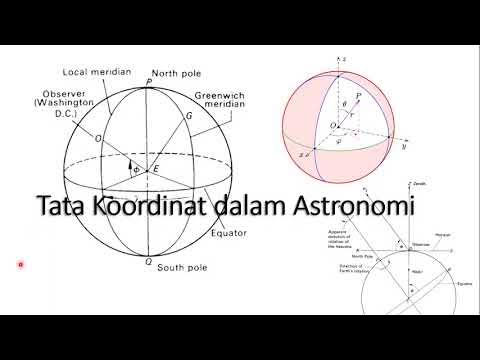Fisika Matematika : Sistem Koordinat Bola
Summary
TLDRThis video lesson covers spherical coordinates, expanding upon previous discussions of polar and cylindrical coordinates. It introduces spherical coordinates (r, theta, phi) and explains how they differ from cylindrical coordinates. The instructor provides visualizations to demonstrate how spherical coordinates relate to Cartesian coordinates (x, y, z) and walks through the analysis of two key planes: the xy-plane and the z-rho plane. The video also discusses trigonometric relations used in spherical coordinates and derives equations for volume and surface elements in spherical geometry. Future lessons will cover Jacobian transformations for these coordinate systems.
Takeaways
- 🌐 Spherical coordinates are represented as (R, Theta, Phi) and differ from cylindrical coordinates, which use (R, Z, Theta).
- 📐 In spherical coordinates, R is the distance from the origin, Theta is the angle with respect to the Z-axis, and Phi is the angle relative to the X-axis.
- 🧭 A point in space can be visualized in both spherical and Cartesian coordinates (X, Y, Z), and their relationship is analyzed geometrically.
- 🎯 The key difference between cylindrical and spherical coordinates is that spherical coordinates introduce angles relative to two axes, not just one.
- 🧩 The two primary planes of analysis in spherical coordinates are the XY-plane and the Z-Rho plane.
- 📊 In the XY-plane, the Y-coordinate is derived using the sine function, while the X-coordinate uses the cosine function, based on trigonometric principles.
- 🛠 The Z-Rho plane analysis involves deriving the Z-coordinate using cosine and the Rho-coordinate using sine, further explaining the relationship with spherical geometry.
- 📏 To calculate volume and surface elements in spherical coordinates, each dimension’s infinitesimal element (dR, dTheta, dPhi) is used.
- 🔄 Volume elements in spherical coordinates are expressed as R^2 sin(Theta) dR dTheta dPhi, derived from geometric and trigonometric considerations.
- 🔑 Surface area and length elements in spherical coordinates are calculated by multiplying infinitesimal elements across the respective dimensions, following geometric interpretations.
Q & A
What is the main difference between spherical and cylindrical coordinates?
-The main difference is that spherical coordinates use three values (r, theta, and phi) to describe a point in 3D space, with r being the radial distance, theta the angle from the z-axis, and phi the angle in the xy-plane. In contrast, cylindrical coordinates use r, theta, and z, where z is the height along the z-axis and theta is the angle in the xy-plane.
How does spherical coordinates differ from Cartesian coordinates?
-Spherical coordinates describe a point using a radial distance and two angles, while Cartesian coordinates use x, y, and z coordinates to represent a point in space. In spherical coordinates, the radial distance from the origin and angles relative to the axes are more intuitive for problems involving symmetry around a point, like in spheres.
What are the three components of spherical coordinates?
-The three components of spherical coordinates are r (the radial distance from the origin), theta (the polar angle, measured from the positive z-axis), and phi (the azimuthal angle, measured from the positive x-axis in the xy-plane).
What is the relationship between spherical and Cartesian coordinates?
-The relationship between spherical and Cartesian coordinates is given by: x = r * sin(theta) * cos(phi), y = r * sin(theta) * sin(phi), and z = r * cos(theta). These equations help convert spherical coordinates to Cartesian coordinates.
What is the role of the angle phi in spherical coordinates?
-The angle phi represents the azimuthal angle in spherical coordinates. It is measured in the xy-plane from the positive x-axis and defines the angular position of a point around the z-axis.
How is the volume element expressed in spherical coordinates?
-In spherical coordinates, the volume element (dV) is expressed as dV = r^2 * sin(theta) * dr * dtheta * dphi. This accounts for the changes in the radial distance (r), the polar angle (theta), and the azimuthal angle (phi).
What is the surface area element on a sphere in spherical coordinates?
-The surface area element on a sphere in spherical coordinates is dA = r^2 * sin(theta) * dtheta * dphi. This expression gives the differential surface area of a small patch on the surface of a sphere.
What does the polar angle theta represent in spherical coordinates?
-The polar angle theta in spherical coordinates represents the angle measured from the positive z-axis.
Outlines

Esta sección está disponible solo para usuarios con suscripción. Por favor, mejora tu plan para acceder a esta parte.
Mejorar ahoraMindmap

Esta sección está disponible solo para usuarios con suscripción. Por favor, mejora tu plan para acceder a esta parte.
Mejorar ahoraKeywords

Esta sección está disponible solo para usuarios con suscripción. Por favor, mejora tu plan para acceder a esta parte.
Mejorar ahoraHighlights

Esta sección está disponible solo para usuarios con suscripción. Por favor, mejora tu plan para acceder a esta parte.
Mejorar ahoraTranscripts

Esta sección está disponible solo para usuarios con suscripción. Por favor, mejora tu plan para acceder a esta parte.
Mejorar ahoraVer Más Videos Relacionados

Geometri Bola dan Takor Geografis | Tata Koordinat dalam Astronomi | KSN Astronomi

Vector Algebra (LEC -33) Polar coordinate system || Polar coordinate system || in Hindi ||

Polar Coordinates Basic Introduction, Conversion to Rectangular, How to Plot Points, Negative R Valu

Matematika SMA - Trigonometri (6) - Koordinat Polar, Koordinat Kutub dan Kartesius (A)

Tensor Calculus 4: Derivatives are Vectors

TRIGONOMETRI (Konversi Koordinat Kutub Ke Koordinat Kartesius)
5.0 / 5 (0 votes)
